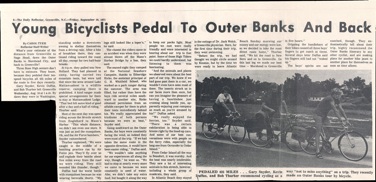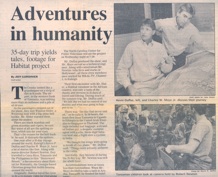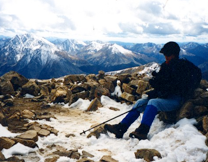
In recent years, Duffus has returned to his life-long passion for North Carolina maritime history. Duffus has combined his 30-plus years of skills at research, writing, photography and editing to produce a series of feature length documentaries. Those productions include: The Graveyard of the Atlantic—400 Years of Shipwrecks, Mysteries and Heroic Rescues, a Telly Award winner; The Cape Hatteras Light—America’s Greatest Sentinel, winner of the gold Aurora Award; and Move of the Century, documenting the remarkable relocation of the Cape Hatteras lighthouse.
In 2001, Duffus completed three years of research, interviews and 700 hours of editing on the three hour production, War Zone—World War Two Off North Carolina’s Outer Banks. War Zone examines a period during World War Two that became one of the greatest maritime disasters in history and the American nation’s worst-ever defeat at sea. For six months over sixty-five German U-boats crossed the Atlantic to hunt Allied merchant vessels practically unopposed and within view of American coastal communities. Three hundred ninety-seven ships were sunk or damaged and
nearly 5,000 people were killed. War Zone features the forgotten lessons of national defense preparedness, feats of exceptional bravery and heroism; and touching stories of lost innocence, of love and of the irrepressible American spirit. War Zone has won numerous awards.
Duffus discovered the location of the lens, and the stunning story of its odyssey, while conducting a yearlong search at National Archives, the Library of Congress, and North Carolina Archives. Thousands of original, hand-written documents were searched for clues to the mystery of the lens. The extraordinary odyssey of the Hatteras lens, and the fate of other lighthouse lenses are described in a book by Duffus titled: The Lost Light—A Civil War Mystery. The book spans 200 years of American history and is a spellbinding tale of plot-twists, ironies, redemption and dishonor. As a result of Duffus' effort, the nationally-significant artifact has been preserved, reconstructed and exhibited at the Graveyard of the Atlantic Museum, in Hatteras, North Carolina.















Lt. John D. (Jack) Duffus in 1944 in the cockpit of his C-47.
Visitng Hong Kong with mother, Nancy, 1966.
Newspaper story about bike trip to Outer Banks 1971.
Free-lancing for ABC Sports 1972.
(Top to bottom): Among recipients of the George Foster Peabody award in New York, 1982 ; sharing contact information with Mrs. Walter Raleigh Gilbert and Geoffrey Gilbert on the Barbican, Plymouth, England, 1984; at CBS News London, 1987.

(Top to bottom): Addressing attendees at the United Nations World Hunger Media Awards as presenters Kenny Rogers and Jane Pauley look on, 1986; with Walter Cronkite in 1989; newspaper story about around-the-world Habitat For Humanity production, 1989; filming on location near Kasulu, Tanzania, 1989.
AP newspaper coverage on Duffus’ discovery of the long-lost Hatteras Fresnel lens, 2002.
©2010 Looking Glass Productions, Inc. USA, All Rights Reserved.

Keynote address at 200th Anniversary celebration of lighthouses at Cape Hatteras, 2003.
In recognition of Duffus' years of research, writing, filmmaking and devotion to the accurate historical record of the Cape Hatteras Light Station, he was chosen to deliver the keynote address at the 200th anniversary celebration at the Cape Hatteras Lighthouse in October, 2003 (read his speech here).
In 2008, after completing years of research, Kevin Duffus published The Last Days of Black Beard the Pirate, a detailed examination of the famous seafaring rogue’s final six months in North Carolina. The controversial book presents stunning contradictions to traditional historical accounts about Black Beard’s origins, his travels and motivations as a pirate, his death, and the identity and fate of his most trusted crew members.
Kevin Duffus is currently on the board of directors of the Blackbeard Adventure Alliance.
Previously, he served for two years as Chairman of the Board of Directors of the Graveyard of the Atlantic Museum, Hatteras, NC.
Stay tuned, there will be more to come!

Duffus’ great-great-grandfather, Michael O’Brien in 1895 photo.
Aboard Walter Cronkite’s ketch in the British Virgin Islands, 1989;on summit of Mt. Elbert (14,485 ft.), highest mountain in Colorado, 2000.



With historian David Stick in 2007.